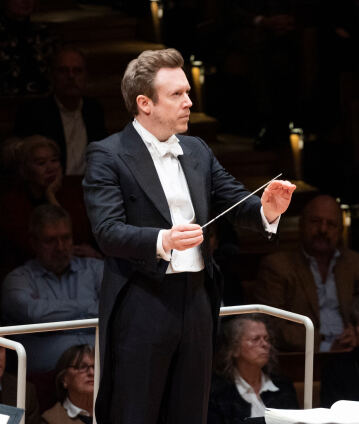Daniel Harding conducts Bruckner’s “Romantic”

A horn call from the tower of a medieval city, forest murmurs, hunting scenes – Anton Bruckner had images like these in mind when he composed his Fourth Symphony. At this concert, Daniel Harding makes the richly coloured “Romantic” shine. Jörg Widmann’s Viola Concerto will be heard beforehand, in which Antoine Tamestit will elicit dark, warm and surprisingly percussive sounds from his instrument. The concert is dedicated to the memory of Claudio Abbado, who died ten years ago on 20 January.
Jörg Widmann was commissioned to compose his viola concerto by Antoine Tamestit himself – and created an extraordinary work for an extraordinary violist. The bespoke solo part is not only notated music, but is also a theatrical performance. Tamestit wanders through the orchestra in seven stages, seeking out different allies along the way. The solo part unfolds an enormous spectrum of expression, ranging from a beginning that consists solely of tapping on the body of the instrument, the dramatic attainment of one’s own bow, technical absurdities, singing, and screaming. Widmann, a witty instrumentalist, mirrors and envelops this unfettered soloist with ever new, dazzling soundscapes for the large orchestra.
If you simply let the Romantic atmospheric images of Bruckner’s Fourth drift over you, you won’t be aware of the hard work the composer put into it. It took Bruckner several attempts to find the final form of the four movements. In the process, the finale in particular gained in importance. As a profound conclusion, it now stands at the end of a symphony with exuberant hunting calls and charming melodies. Daniel Harding has often demonstrated his flair for large-scale works when conducting the Berliner Philharmoniker, impressively succeeding in creating a symbiosis of agility and sonority.
© 2024 Berlin Phil Media GmbH
Related interviews
Artists
Our recommendations
- Daniel Harding and Gerald Finley with works by Schubert and Strauss
- Daniel Harding conducts “Thus spoke Zarathustra”
- Daniel Harding conducts Debussy, Ligeti, Sibelius and Britten
- Daniel Harding conducts Mahler’s First Symphony
- Daniel Harding conducts Berlioz’s “Roméo et Juliette”
- A Mozart evening with Daniel Harding